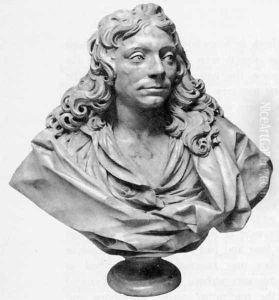Edward Pearce Paintings
Edward Pearce was an English sculptor and architect who worked during the 17th century, a period that saw considerable change and development in English art and architecture. Pearce was born in 1630, during a time of political turmoil in England which would eventually lead to the English Civil War. Despite the challenges of the era, Pearce developed his craft and became noted for his work in both sculpture and architecture.
Edward Pearce's career was notably diverse, as he was skilled in creating funerary monuments, decorative sculptures, and architectural designs. His works are characterized by the Baroque style, which was prevalent in Europe during this period. The Baroque style is known for its grandeur, dramatic tension, and rich, deep details. Pearce's sculptures often featured elaborate drapery, dynamic figures, and a strong sense of movement, all of which are hallmarks of the Baroque aesthetic.
One of Pearce's significant contributions to architecture was his work on the rebuilding of the city of London after the Great Fire of 1666. He collaborated with Sir Christopher Wren, one of the most prominent architects of the time, on several projects. Pearce's sculptural works can be found in various churches and cathedrals, including St Paul's Cathedral, where his craftsmanship added to the ornate interior that is admired to this day.
Despite the prominence of his works during his lifetime, Edward Pearce is not as widely remembered as some of his contemporaries. This can be attributed to the overshadowing fame of architects like Wren and the lesser documentation of artists during that period. Pearce died in 1695, leaving behind a legacy that contributed to the rich tapestry of English Baroque art and architecture. His works remain an important part of the cultural heritage and provide insight into the artistic endeavors of the period following the restoration of the English monarchy.
